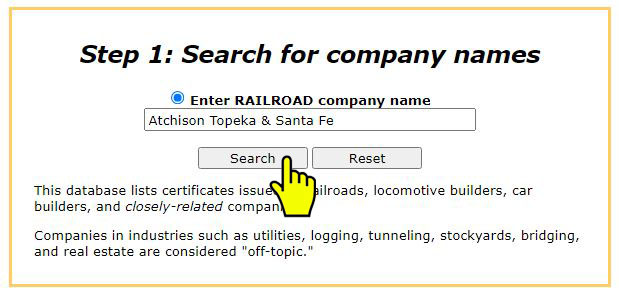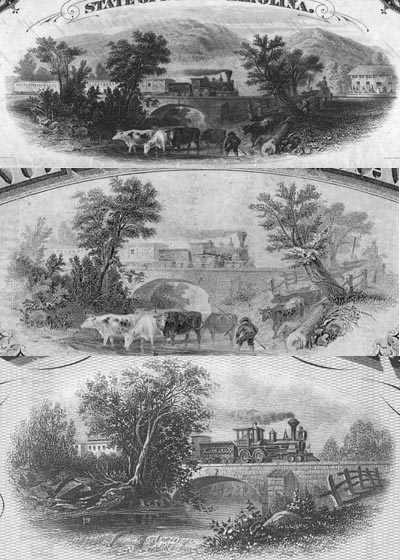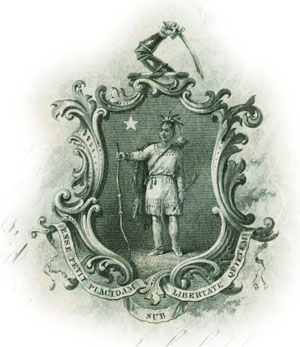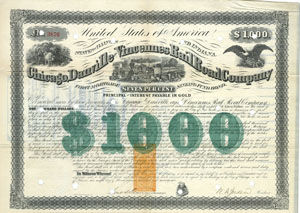How to identify varieties
Locating specific certificates in the project database is a three-step process.
- Search for the appropriate company name
- Decide whether you want to see certificates labeled as Stocks, Bonds or Others
- Find a description or image that most closely resembles the certificate you're interested in.
STEP 1: Locate specific company NAMES
Enter company names in the search box and hit ENTER or click "Search."

Depending on the words you entered, you will be provided with one or more possible company names. Pick the one you're interested in.


Most company names are easy to find. Or, at least SEEM easy to find. Here are some companies to watch out for:
- Companies that incorporated multiple times
- look carefully at "Railway" vs "Railroad" (see the example at right)
- look carefully at incorporation dates
- Companies which used their names inconsistently
- look carefully for variations of "Rail Road" vs "Rail-Road" vs "Railroad" etc.
- look for variations in spelling of place names ("Pittsburg" vs "Pittsburgh")
- look carefully for the use of hyphens
- look for the word "The"
- Companies mentioned in bonds that were issued by counties, states, and provinces
- "aid bonds" always mention specific railroad names in the body of text
- certificates usually refer to specific acts of state or provincial legislatures
- Companies represented by equipment trust certificates
- certificates strongly resemble vertical format bonds and are denominated in currency
- certificates usually display words like "Equipment Trust" or "Car Trust"
- certificates usually display a trustee company name near the title and near signature lines at the bottom
- company names are followed by words like "railroad" and "railway," but NOT followed by the "word company" or "corporation"
STEP 2: Locate specific certificate TYPES
Depending on the types of certificates known and cataloged, you will be presented with a choice of certificate types. This project forces all certificates into three types:
- stocks
- these certificates always display the word "share" or (occasionally) "parts"
- bonds*
- these certificates always display currency denominations
- these certificates always display wording similar to "The XYZ Railroad Company promises to pay to __________________ or assigns the sum of One Thousand Dollars ..."
- interest rate is usually mentioned in the first few lines of text
- these certificates often display the word "Bond" somewhere near the company name
- others
- these certificates do not fit into either the stock or bond category
- these certificates had widely variable purposes
- certificates usually mention shares or dollars, but not with the same wording as stocks or bonds
- very few of these certificates display vignettes
- many of these certificates conveyed rights to stocks and bonds or were convertible into them
*Equipment Trust Certificates (ETCs): These are hybrid documents, These are always denominated in currency values (usually $1,000), but sold in "shares." I classify all equipment trusts among bonds because they strongly resemble vertical format bonds and had specific lifespans like bonds.
Click either the small plus symbol ("+") at the left of a certificate type, or click "Show All." The plus sign will step you one or more choices.

If ever in doubt about whether you have the correct document type, look at the top corners of certificates.
- If there is a dollar sign ("$") or a Pound symbol ("£"), examine descriptions or images under the "Bonds" designation.
- If there is wording similar to "This is to certify that ________________________ is entitled to ______________ shares in the Capital Stock...", examine descriptions or images under the "Stocks" designation.
- If neither of those two designations match your certificate well, start examining certificates under the "Other" category.
- If no description proves a good match, take a picture or scan of your document and send it to me.
Locate specific certificate VARIETIES
In complicated series, there may be two or three more choices to decide upon. The "Show All" will display all cataloged certificates at once. Descriptions always proceed from most obvious to more obscure.

Pattern matching: the first step toward identifying details and varieties

Humans are highly adept at spotting patterns and similarities in practically every endeavor. Anyone new to a collecting hobby will encounter numerous items that seem dramatically similar. As they amass more and more items, they begin noticing differences that they initially overlooked. In most collecting hobbies, small differences can mean large disparities in availability and consequently price.
Small and highly variable features abound in our hobby of stocks and bonds. If all were used to split varieties into ever-smaller groups, the number of cataloged varieties could easily quadruple with no discernable effect on prices. Participants in the coin, stamp and currency hobbies commonly pay hefty premiums for trivial differences among varieties and sub-varieties.
Collectors in the scripophily hobby DO NOT.
At right are three vignettes found on several varieties of stocks and bonds. The top example is named "The Crossing." It was engraved by James Smillie and first appeared on $5 notes of the North Western Bank of Warren, Pennsylvania. A more elaborate version appears on Peruvian bonds of the National Company of the Mineral Railroad of Pasco (Compañia Nacional del Ferrocarril Mineral de Pasco.) The details on both are so precise that, with a hand lens or microscope, one can read "Look out for bell rings" on a sign that appears between the tree and a horse rider near the right side.
The second and third engravings share gross details with "The Crossing" and with each other. After you spend a few minutes identifying details and differences between all three, you will come away with a sharper eye for finding distinctive details on certificates.
This project intends to identify and describe meaningful differences between varieties in such a manner that users will be able to discriminate between varieties. The goal is NOT to describe every vignette nor every detail.
Identifying varieties in the stock and bond (scripophily) hobby can be tricky because companies took many different approaches to the subject of security documents. The features used for differentiating certificates in one company can be distinctly different in another company.
The majority of railroad companies had short lifespans and therefore issued few types of securities. Identifying varieties is easy when companies issued only one type of stock certificate and one type of bond. At the other end of the spectrum are companies like the Baltimore and Ohio Railroad which existed for over a century and a half. This project has cataloged a large number of varieties and notable sub-varieties of certificates for that company. The company probably issued even more certificates that have long since been redeemed and destroyed.
Once you've decided upon a certificate ...
You will be presented with a screen that offers different types of information depending on certificate type.

You will notice features such as the catalog number, colors, share or bond values, and a "Frequency" number. That is an estimate of how often certificates have appeared over the last thirty-plus years. In many cases, you will notice a blue "#" symbol. Click on that to see a lisy of all serial numbers recorded to date. Those serial numbers will give you a "feel" for how common or scarce certificates might be.

At the far right is a price estimate expressed as a range in dollars. That is my estimate of prices you are likely to encounter if buying form a professional dealer in the United States. Depending on rarity and where you shop, prices can be notably higher or lower than even my estimates. Click on that price range and see how prices have behaved over the last twenty years.

Finally, if there is a small image of your certificate, click on the thumbnail image of a certificate and you will be presented with an image about three times larger. Use larger images to check for smaller details, and possibly even discover new varieties or variations.

Companies often changed certificate designs
Railroading was big business in the 1800s, but that does not mean they all made big money. Financial fortunes of railroads changed constantly. Mergers, consolidations, bankruptcies, and new incorporations were the rule. All those changes meant securities needed to change in response. Take the Baltimore & Ohio Railroad Company as an example. The company issued millions of stock certificates and several hundred thousand bonds. Based strictly on certificates known to collectors, we know of eight different stock certificate designs, No collector from any hobby would have a problem lumping all B&O certificates into eight piles.
During that process, even a casual observer would notice a difference in the background behind the ancient train named "Novelty." By the time a beginner sorted through a few hundred random B&O stock certificates, he or she would notice differences in stock types (capital vs. common vs. preferred), the presence or absence of allegorical females and maybe the words "New York Certificate" or "Baltimore Certificate" in the top margin of some. Even if color blind, that same beginner would notice differences in denominations. At minimum, a collector of any collecting hobby could sub-divide B&O certificates into at least 35 "varieties" without even pausing to notice variations in printers, signature lines, textual variations and printed dates. Seasoned collectors have helped push the number of B&O variations to 150-plus.
Make no mistake; few of those secondary variations have any effect on normal prices. So why "split hairs" so much?
It is important – EXTREMELY important – for questioners to realize that more than half of the collectors who correspond with me relish the idea of finding new, unreported variations. Finding new minor variations is NOT hard. Keeping further sub-varietization in check is a more difficult problem. There have been a few circumstances where I saved time cataloging minor variations rather than explain and re-explain why they should be ignored. I know my listing of minor varities drives dealers wild, but input from collectors is the reason I currently list at least 55 "sub-varieties" of B&O certificates.
One of my long and now-deceased correspondents had a name for the searching for microscopic variations among certificates: "flyspeck scripophily." By that he meant identifiable, but minor variations that had no discernable effect on prices, collectability, or collector interest. Collectors love to report flyspeck variations and dealers hate them. Finding variations in our hobby is one thing; paying extra for them is another thing entirely. Hence the reason dealers will not mess with them. I discuss more about flyspeck sub-varieties in their own special page.
Some flyspeck variations MUST be cataloged

Pushing aside arguments over whether to include or exclude specific "flyspecks," some types of those small variations must be described because they serve as the easiest ways to identify variations. In many cases, other variations are simply too difficult to describe in few words.
The most-useful flyspecks in this project are printed portions of dates. I have not knowingly encountered any collector who willingly pays premiums to acquire a specific type of printed date, but they DO pay for variations associated with easier-to-see flyspecks. I have another special page where I discuss dates in more detail.
CUSIP numbers

CUSIP numbers began to appear on stocks and bonds beginning in the early 1970s. The CUSIP number system was created by a group of security clearing house and security industry officials in cooperation with the American Bankers Association. While not legally mandated, the industry strongly suggested that issuers of securities print the number on certificates to enable more efficient movement through the clearing house system. I suggest that the number became as necessary as serial numbers and its presence important to variety identification in this project. More discussion can be found on the CUSIP number page on this website.
Vignettes of state seals
State seals are highly valuable for determining where companies incorporated. Deep discussion on discovering the names of states associated with engraved vignettes can be found at a special page on this web site that displays examples of all official state seals as well as a State Seal Finder page.
Imprinted revenue stamps

The United States government required the addition of revenue stamps to stocks and bonds to help pay for costs of the Civil War and The Spanish-American War. This project DOES NOT record or valuate adhesive revenue stamps attached to security but DOES report varieties with imprinted revenues. See a special Revenue Imprints page on this website to learn more about imprinted revenues found on certificates.
Certificates altered during or after issuance
A substantial number of certificates show handwritten, typewritten and rubber-stamped alterations. Just like most legal documents, hand-alterations are accepted and legal practice. It was fairly common for companies to change names through merger, consolidation, or preference and to issue old certificates before replacement by newer editions. Parts or all of old names were simply crossed out and new names written in. Since the name changes represented issuance of new companies, this project always catalogs altered certificates under new company names.
Other types of frequently-seen alterations include changes to par values, capitalization amounts, denominations, officer names, and even certificate type. See more discussion at a special alterations page.
Certificate colors
Many stock and bond collectors have come to the hobby with previous experience collecting stamps. That is a hobby where fine descriptive distinctions can have notable price ramifications. That is NOT the case in this hobby. I explain more about the project stance on a special page about color descriptions.
What about text and vignettes on the backs of certificates?
I do NOT describe, record, or keep information about the backs of certificates for three principal reasons:
- Economic pragmatism. I have never encountered a shred of evidence that collectors pay premiums for anything on the backs of certificates other than autographs or revenue stamps. The code "ITASB" code used in descriptions ("issued to and signed by") indicates that stock holders and bondholders signed the backs of certificates during sale and transfer. I do not report or estimate values of stamps that might appear there.
- Avoidance of flyspeck varietization. It is easy to find differences in text on the backs of certificates, but describing them would be laborious,; again, devoid of collector premiums.
- Practicality. Professional auction houses and dealers never show or report back designs. Even if contributions were solicited from collectors, it would probably not be possible to collect more than a few thousand images.
Features frequently used to describe differences between varieties
- Company names including alterations and modifications
- Company incorporation locations (stated or implied from state seals)
- Type of certificate (stock, bond, other)
- Document sub-types (preferred, common, 1st mortgage, debenture)
- Series designations (Series A, Second class)
- Document formats or shapes (square, vertical, horizontal)
- Border colors
- Denominations (printed or engraved)
- Vignette descriptions
- Vignette locations
- Stamp frames
- Imprinted revenues from the United States
- Printed dates or printed portion of dates
- Alignments or shapes of company names
- Signature types (facsimile or handwritten)
- Alignments or positions of features
- Underprints or overprints
Features normally ignored for identifying varieties
- Very small features
- Features on backs of certificates
- Colors of paper seals
- Paper colors
- Minor border or underprint color variations
- Watermarks in paper
- Adhesive stamp types
- Non-North American imprinted revenues
- Signatures of company officials, registrars or counter signatures
- Redemption dates on equipment trust certificates
- Places where certificates were transferrable or redeemable